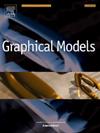Computing medial axis of a simple polygon in linear time based on R-L sequence
IF 2.2
4区 计算机科学
Q2 COMPUTER SCIENCE, SOFTWARE ENGINEERING
引用次数: 0
Abstract
Medial axis computation has wide applications in pattern recognition, image processing, finite element mesh generation, and CNC tool path extraction. Aiming to explore intrinsic geometric attributes of the medial axis of a simple polygon which can be accurately represented and faces its challenge of computational efficiency, an R-L sequence-based algorithm of linear computational complexity is proposed for achieving much higher efficiency; especially, it enables the complexity of Delaunay triangulation to be linear. The algorithm is done by reconstructing the Voronoi diagram tree of the given simple polygon, which can be easily performed in a breadth-first manner with a higher computational efficiency. The branches of the medial axis are naturally divided into several panels, such that the branches in the same panel cause no interference with each other and decrease a lot of computational costs. Based on our experiments, the efficiency of the proposed R-L algorithm can be 6 to 17 times greater than that of the state-of-the-art method in TVCG, and up to 419 times greater than the CGAL algorithm. In principle, it can be directly applied to compute the medial axis of curvilinear polygons, which expands the scope of application compared to Chin’s method.

基于R-L序列在线性时间内计算简单多边形的中轴线
中轴计算在模式识别、图像处理、有限元网格生成和数控刀具路径提取中有着广泛的应用。为了探索可精确表示的简单多边形中轴线的内在几何属性,面对其计算效率的挑战,提出了一种基于 R-L 序列的线性计算复杂度算法,以实现更高的效率,特别是使 Delaunay 三角剖分的复杂度成为线性。该算法通过重建给定简单多边形的 Voronoi 图树来完成,可以轻松地以广度优先的方式执行,具有更高的计算效率。中轴的分支被自然地划分为多个板块,这样同一板块中的分支就不会相互干扰,从而降低了大量的计算成本。根据我们的实验,所提出的 R-L 算法的效率是 TVCG 中最先进方法的 6 到 17 倍,是 CGAL 算法的 419 倍。原则上,它可以直接用于计算曲线多边形的中轴线,与 Chin 的方法相比扩大了应用范围。
本文章由计算机程序翻译,如有差异,请以英文原文为准。
求助全文
约1分钟内获得全文
求助全文
来源期刊

Graphical Models
工程技术-计算机:软件工程
CiteScore
3.60
自引率
5.90%
发文量
15
审稿时长
47 days
期刊介绍:
Graphical Models is recognized internationally as a highly rated, top tier journal and is focused on the creation, geometric processing, animation, and visualization of graphical models and on their applications in engineering, science, culture, and entertainment. GMOD provides its readers with thoroughly reviewed and carefully selected papers that disseminate exciting innovations, that teach rigorous theoretical foundations, that propose robust and efficient solutions, or that describe ambitious systems or applications in a variety of topics.
We invite papers in five categories: research (contributions of novel theoretical or practical approaches or solutions), survey (opinionated views of the state-of-the-art and challenges in a specific topic), system (the architecture and implementation details of an innovative architecture for a complete system that supports model/animation design, acquisition, analysis, visualization?), application (description of a novel application of know techniques and evaluation of its impact), or lecture (an elegant and inspiring perspective on previously published results that clarifies them and teaches them in a new way).
GMOD offers its authors an accelerated review, feedback from experts in the field, immediate online publication of accepted papers, no restriction on color and length (when justified by the content) in the online version, and a broad promotion of published papers. A prestigious group of editors selected from among the premier international researchers in their fields oversees the review process.
 求助内容:
求助内容: 应助结果提醒方式:
应助结果提醒方式:


